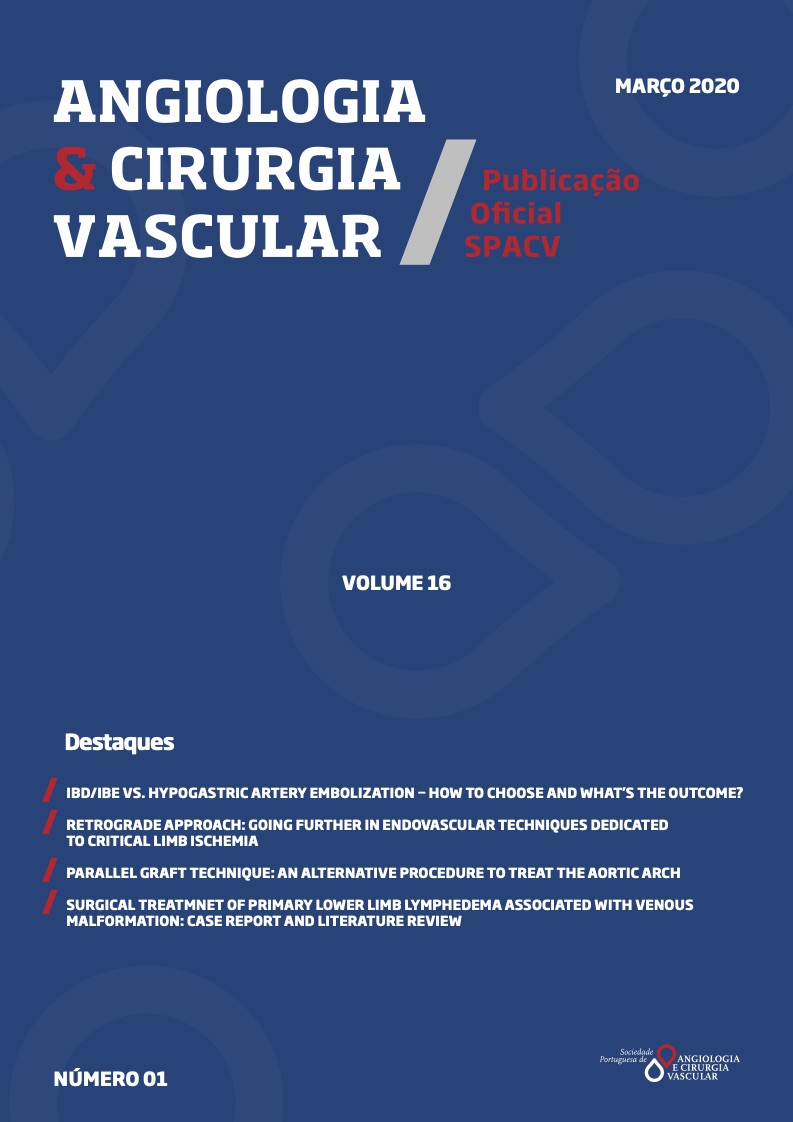REVIEW OF THE SURGICAL OUTCOMES OF AORTIC FISTULAS: EXPERIENCE OF A DEPARTMENT
DOI:
https://doi.org/10.48750/acv.241Keywords:
Fistula, Aortoenteric, Aortocaval, AortoesophagealAbstract
Introduction and methods: The approach of patients with fistulas of the aorta remains a challenge in Vascular Surgery. The objective of this paper is to review the surgical outcomes of patients with fistulas arising from the descending thoracic and abdominal aorta through consultation of the patient’s clinical file during 16 years in a Vascular Surgery Department.
Results: From a total of twenty-two cases, twenty patients were identified (two patients with consecutive primary and secondary fistulas) with a mean age of 66,6 years. Eighteen patients were male and 50% of the cases correspond to primary fistulas. The location of the fistula was aortocaval in five, aortoduodenal in fourteen, aortoesophageal in three and aortojejunal in two cases. Abdominal primary fistulas were mostly associated with an aortic abdominal aneurysm. Regarding secondary fistulas, the previous surgical intervention was aortobifemoral bypass in four and aortic grafts in seven cases. The time between intervention and fistula diagnosis ranged from 2 months to 19 years. The most common clinical presentation was hematemesis in 59% and lower gastrointestinal bleeding in 32%, with hypovolemic shock in 41% of the cases. All patients were submitted to conventional surgery except for the three aortoesophageal cases that were treated by endovascular surgery. In aortoenteric fistula the third portion of duodenum was the most affected and intestinal surgery was performed in 72,7% of the cases. In patients with secondary fistulas, removal of the conduit was performed in eight cases, however a lower limb revascularization procedure was only attempted in five. The most common complication in the post-operative period was lower limb gangrene, corresponding to an amputation rate of 25%. Eight patients required a second surgical procedure as thrombectomy or lower limb major amputation, endovascular exclusion of a persistent fistula and Hartmann’s procedure. Mortality was 50%, corresponding to four cases of primary fistulas and seven cases of secondary. The median time of hospital stay was 22,4 days. The patient’s survival ranged from two months to sixteen years and among the known mortality cases are secondary fistula after primary fistula, bowel ischemia, fistula persistency despite correction, pneumonia or prothesis infection.
Conclusion: Fistulas arising from the aorta are a medical entity with a high surgical mortality rate. The presented results meet those previously published in the literature.
Downloads
References
2. Hallett JW Jr, Marshall DM, Petterson TM, Gray DT, Bower TC, Cherry KJ Jr, et al.Graft-related complications after abdominal aortic aneurysm repair: reassurance from a 36-year population-based experience. J Vasc Surg. 1997;25:277–84.
3. Baker WH, Sharzer LA, Ehrenhaft JL: Aortocaval fistula as a complication of aortic aneurysms. Surgery. 1972;72:933–9.
4. Milner R., Minc S. Chapter 49. Local Complications: Aortoenteric Fistula. Rutherford’s Vascular Surgery and Endovascular Therapy, 1-Volume Set, 9th ed. 2018:615–23.
5. Kakkos SK, Bicknell CD, Tsolakis IA, Bergqvist D; Hellenic Co-operative Group on Aortic Surgery. Management of Secondary Aorto-enteric
and Other Abdominal arterio-enteric Fistulas: a Review and Pooled Data Analysis. Eur J Vasc Endovasc Surg. 2016;52(6):770–86
6. Spanos K, Kouvelos G, Karathanos C, Matsagkas M, Giannoukas AD.Current status of endovascular treatment of aortoenteric
fistula. Semin Vasc Surg. 2017;30(2–3):80–4.
7. Nakad G, AbiChedid G, Osman R. Endovascular Treatment of Major Abdominal Arteriovenous Fistulas: a Systematic Review. Vasc Endovascular Surg. 2014;48(5–6):388–95.
8. Canaud L, Ozdemir BA, Bee WW, Bahia S, Holt P, Thompson M.Thoracic endovascular aortic repair in management of aortoesophasgeal
fistulas. J Vasc Surg. 2014;59(1):248–54.
9. Jonker FH, Schlösser FJ, Moll FL, van Herwaarden JA, Indes JE, Verhagen HJ, et al. Outcomes of Thoracic Endovascular Aortic Repair
for Aortobronchial and Aortoesophageal fistulas. J Endovasc Ther. 2009;16(4):428–40.
10. Rodrigues dos Santos C, Casaca R, Mendes de Almeida JC, Mendes-Pedro L. Enteric Repair in Aortoduodenal Fistulas: A Forgotten but
often lethal player. Ann Vasc Surg. 2014;28(3):756–62.









